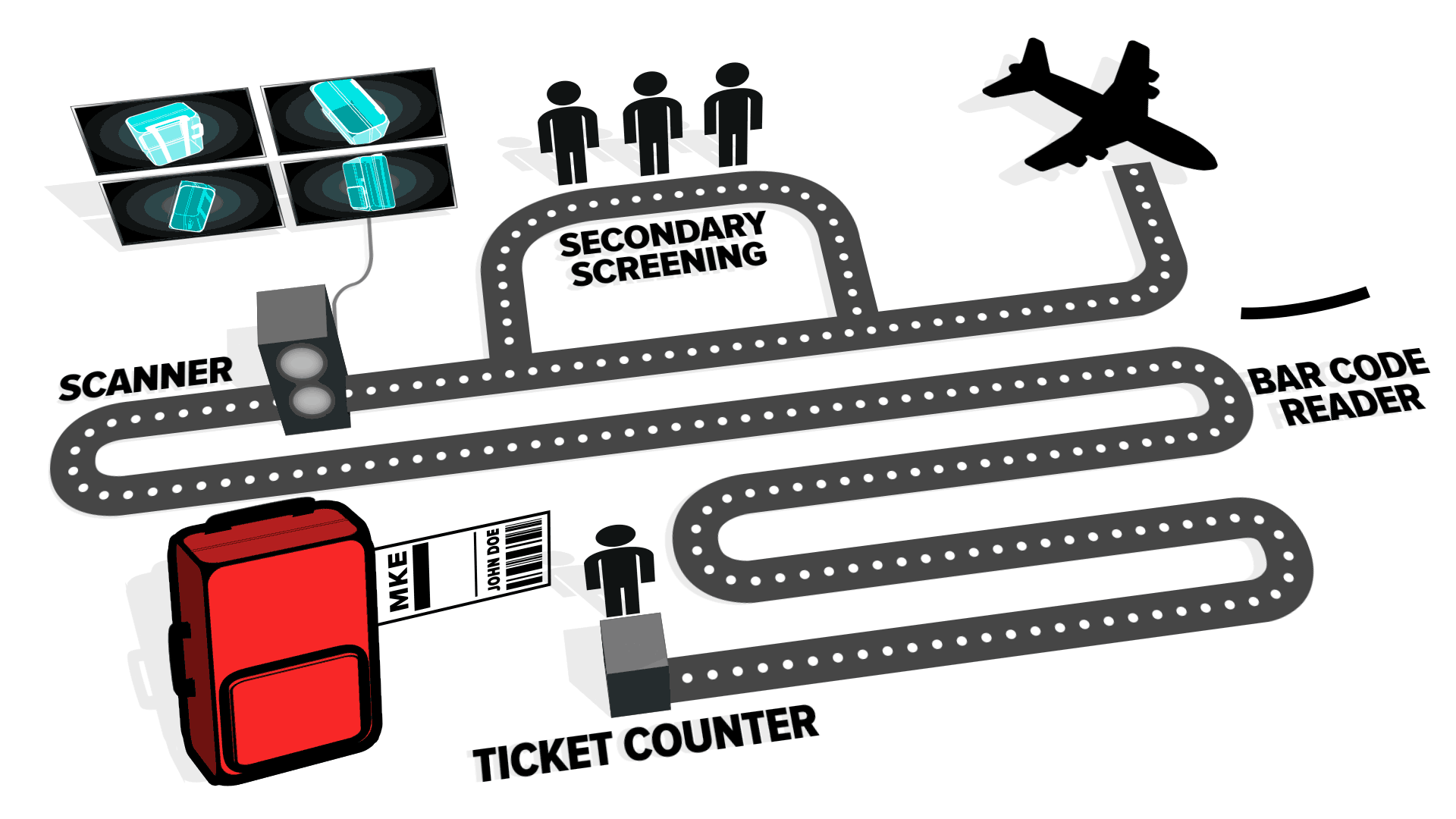In an era where global travel is becoming increasingly prevalent, ensuring the safety and security of passengers is paramount. The aviation industry has long been a target for potential threats, necessitating stringent security measures. Traditional methods, while effective to a degree, are labor-intensive and subject to human error. This is where Artificial Intelligence (AI) and Machine Learning (ML) step in, offering revolutionary advancements in threat detection.
AI and ML algorithms can significantly enhance the performance of automated threat detection systems, especially in areas such as passenger screening, carry-on luggage inspection, and checked luggage analysis. These technologies not only improve the accuracy and efficiency of security processes but also alleviate the workload on human operators, allowing them to focus on more critical tasks.

Checked Baggage
Importance
Checked baggage is vitally important to screen properly as it can be used to conceal large quantities of contraband or explosives. Thorough screening of checked baggage is essential to ensure the safety of passengers, crew, and aircraft. Unlike carry-on luggage, checked baggage is not accessible by the passenger while the aircraft is in flight. Rules and regulations vary, but often items not allowed in carry on luggage like sharp objects, blunt tools, and even declared firearms and ammunition (when stored properly and only in certain countries or territories) can be stored in checked luggage. This creates a different threat detection problem, but one equally vital to accomplish with speed, precision, and accuracy in the screening process.

Challenges
- Manual Inspection: Traditional methods rely heavily on manual inspections and basic imaging technologies, which can be inefficient, error-prone, and costly.
- Volume: The sheer volume of checked baggage at large airports makes it difficult to thoroughly inspect every piece. Screener fatigue can negatively impact accuracy and speed of the screening process.
- False Positives: High rates of false positives can cause delays and require additional manual inspections, or create chaos in the luggage handling process.
AI and ML Solutions
- Advanced Imaging and Analysis: AI-powered systems use advanced imaging technologies such as CT scanners to create detailed 3D images of checked luggage. These images are analyzed by ML algorithms trained to identify a wide range of potential threats. Properly trained and tested detection algorithms don't suffer fatigue and can clue in on things even the most experienced baggage screeners might miss.
- Continuous Learning and Improvement: These systems can continuously improve their threat detection capabilities by analyzing new data and refining their algorithms, ensuring they stay effective against evolving threats. Once trained, certified, and approved for deployment, algorithms need only be installed into the equipment and replace the older versions to bring the latest detection capabilities to the operational environment.
Carry-On Baggage
Importance
Carry-on baggage presents a significant security concern as passengers have direct access to these items during flights. Ensuring that carry-on baggage is free of weapons, explosives, and other contraband is crucial for maintaining in-flight safety not just for the aircraft, but for passengers and aircrew. Detection algorithms for carry-on baggage must be capable of detecting or alarming explosives, sharp objects, blunt tools or weapons, and firearms in a manner that ensures they do not cross into the secure areas of the airport. TSA continues to regularly publish the confiscation rates for finding firearms in carry on baggage even today.
Challenges
- Limited Information: Traditional X-ray machines provide limited information, often requiring manual inspection by security personnel.
- Speed vs. Accuracy: Ensuring thorough inspections while maintaining efficient passenger flow is a constant balancing act. Speed and accuracy are key to keeping the passenger experience positive.
- Human Error: Manual inspections are prone to human error, which can lead to missed threats. False alarms also slow down checkpoint lines and can cause frustration in TSA personnel and passengers alike.
AI and ML Solutions
- Automated Threat Recognition: AI algorithms can be integrated with X-ray and CT scanners to automatically detect potential threats within carry-on luggage. These systems analyze the contents of bags in real-time, identifying items such as weapons, explosives, and other contraband. High performing algorithms assist the Transportation Security Officers (TSOs) in zeroing in on potential threat objects, providing the TSO with additional tools and detection power while they screen carry on luggage of all shapes, sizes, and contents.
- Efficiency and Speed: By automating the threat detection process, AI reduces the need for manual inspections, allowing security personnel to focus on more critical tasks. This speeds up the screening process and minimizes the risk of human error. The outcome is a better experience for TSOs and passengers, more passenger throughput at the security checkpoints, and more passengers on planes for the airlines.

On-Person Screening
Importance
On-person screening is critical for detecting items concealed on a passenger's body, such as weapons or explosives. Ensuring non-invasive and efficient screening processes is essential for maintaining passenger privacy and comfort while keeping dangerous materials and objects out of airplanes. On-person screening presents one of the most unique challenges in the need for privacy for traveling passengers. While the body scanners can create accurate and detailed images, federal law in the United States prohibits the retention of any scans and the display of true scans on any screen. This limitation means data cannot be held after the screening process for collection or review, but also helps to ensure passenger privacy. As a result, detection methods need to not only be accurate in their detection capabilities, but also able to display detections on a universal body figure in an accurate location.

Challenges
- Privacy Concerns: US law forbids the retention and display of true body images for privacy reasons, which creates challenges in data collection and analysis. This legal requirement reinforces the need for non-invasive screening methods that respect passenger privacy. Additionally, the variety in the human form creates additional challenges in the object detection and alarm display functionalities.
- Detection Accuracy: Traditional methods can be intrusive and uncomfortable for passengers, leading to a need for more accurate and less invasive technologies. These methods also are time consuming and present additional risk of litigation if mishandled. Falling back solely to metal detection leaves a major gap in potential threat vectors that cannot be relied upon long term.
- False Positives: High rates of false positives can lead to unnecessary delays and additional screening, causing passenger discomfort and inconvenience. Any time a security checkpoint starts to backup due to additional screening steps, the risk of missed flights and frustration only grows.
AI and ML Solutions
- Enhanced Image Analysis: Modern body scanners equipped with AI can analyze detailed 3D images of passengers very quickly. These systems use ML algorithms to identify potential threats such as weapons, explosives, or other contraband items concealed under clothing without displaying or retaining true body images. Potential threat objects are then relied with precise location informing the TSOs where to localize any additional screening steps, increasing efficiency and decreasing unnecessary touches, pats, or searches.
- Reduced False Positives: AI-driven systems are capable of distinguishing between harmless items and potential threats with greater accuracy. By reducing false positives, these systems streamline the screening process, ensuring that passengers can move through security checkpoints more efficiently.
- Non-Invasive Screening: AI and ML technologies enable the development of non-invasive screening methods that maintain passenger privacy and comfort while maintaining a high security posture at the checkpoint. This ultimately results in quick staff screening, improved customer experience, and less risk to TSO team members from conducting unnecessary false alarm follow up searches.
The Impact on Security Personnel
While AI and ML offer significant advantages in threat detection, they are not designed to replace human security personnel. Instead, they complement and enhance their capabilities. By automating routine tasks and reducing the workload on human operators, AI enabled solutions allows security personnel to focus on more critical and complex aspects of security screening. Any time you can remove false alarms from any type of screening process you save significant amount of operator time from the additional screenings and searching steps that follow. This additional time savings reinvests in the checkpoint by allowing those same TSOs to help monitor the line for suspicious activity, assist passengers with special needs or disabilities to navigate the process, and spend more time on detections that are more likely to be true threat objects. Performance wise, the automated detection element serves to bolster and enhance seasoned TSO screeners by assisting them in spotting details easily missed by the human eye. In this way, the AI serves as a tool for the TSO who then weighs in with their training and contextual knowledge to make a more informed decision on whether to further screen the passenger or bag, or to clear it.

Training and Development
AI and ML systems can also be used to train security personnel by keeping them up to date on tomorrow's luggage contents and emerging threats as they develop. Additionally, AI and ML systems can assist individual performance by analyzing past data and identifying patterns. These systems can highlight areas where additional training is needed and even help to generate the type of scenarios that address those specific needs. This ensures that security personnel are always equipped with the latest knowledge and skills to handle emerging threats and that feedback from anywhere in the aviation security industry can help improve performance anywhere else in the country, or even the globe.
The Future of AI and ML in Aviation Security
The future of aviation security lies in the continued integration of AI and ML technologies. As these technologies evolve, they will become even more effective at detecting threats and improving the overall security process. The development of new AI algorithms and the accumulation of more data will further enhance the capabilities of these systems. To fully realize the potential of AI and ML in aviation security, collaboration and integration are key. Security organizations, technology providers, and regulatory bodies must work together to develop and implement standardized solutions. This includes the integration of AI systems with existing security infrastructure and the sharing of data to improve threat detection capabilities.

Addressing Challenges
While AI and ML offer significant advantages, they also present challenges that must be addressed. These include issues related to data privacy, algorithm bias, data collection and dissemination, and the need for robust cybersecurity measures. By addressing these challenges proactively, the aviation industry can ensure that AI and ML are used responsibly and effectively to improve both security outcomes and the passenger experience.
AI and ML are revolutionizing aviation security by enhancing the accuracy and efficiency of threat detection systems. From passenger screening and carry-on luggage inspection to checked luggage analysis, these technologies offer significant benefits. By automating routine tasks and providing more accurate information, AI allows security personnel to focus on more critical aspects of security.
The continued development and integration of AI and ML technologies will play a crucial role in ensuring the safety and security of passengers worldwide. For organizations looking to stay ahead of emerging threats and enhance their security processes, now is the time to invest in AI and ML solutions.
If you are interested in learning more about threat detection, custom Automated Threat Recognition (ATR) systems, or integration with the Open Platform Software Library (OPSL), DICOS, or the EOS API, we encourage you to reach out to Stratovan. Our team of experts is ready to help you enhance your aviation security with cutting-edge AI and ML technologies. Contact us today at Stratovan to discuss your needs and explore how we can assist you in achieving your security goals.
Together, we can create a safer and more secure aviation environment for everyone.
